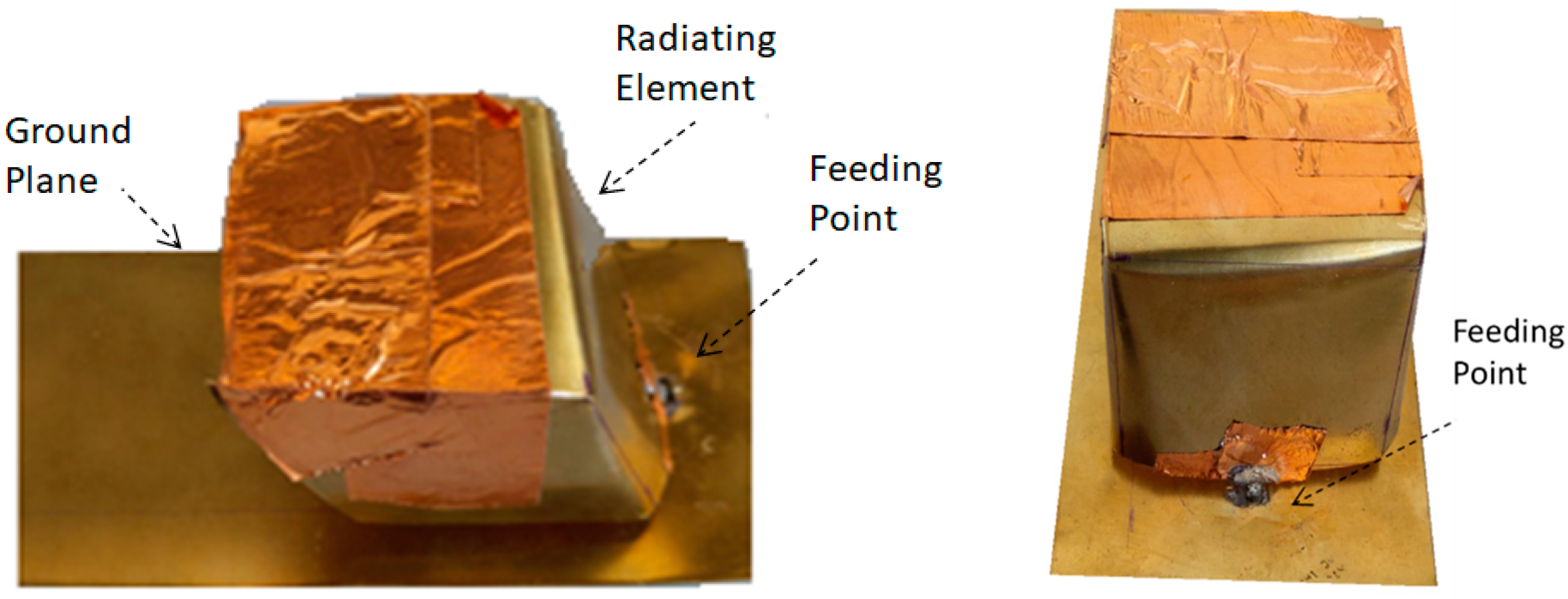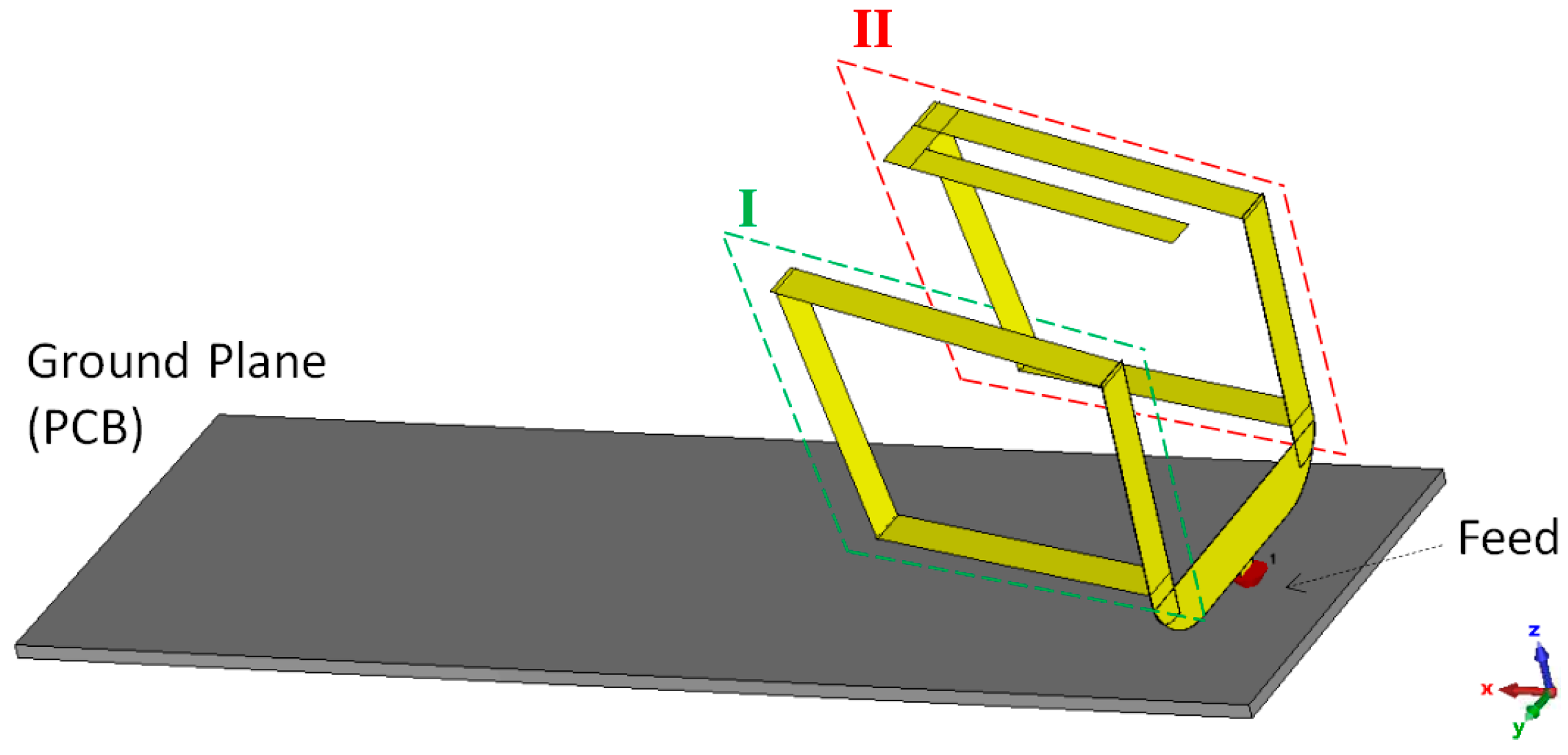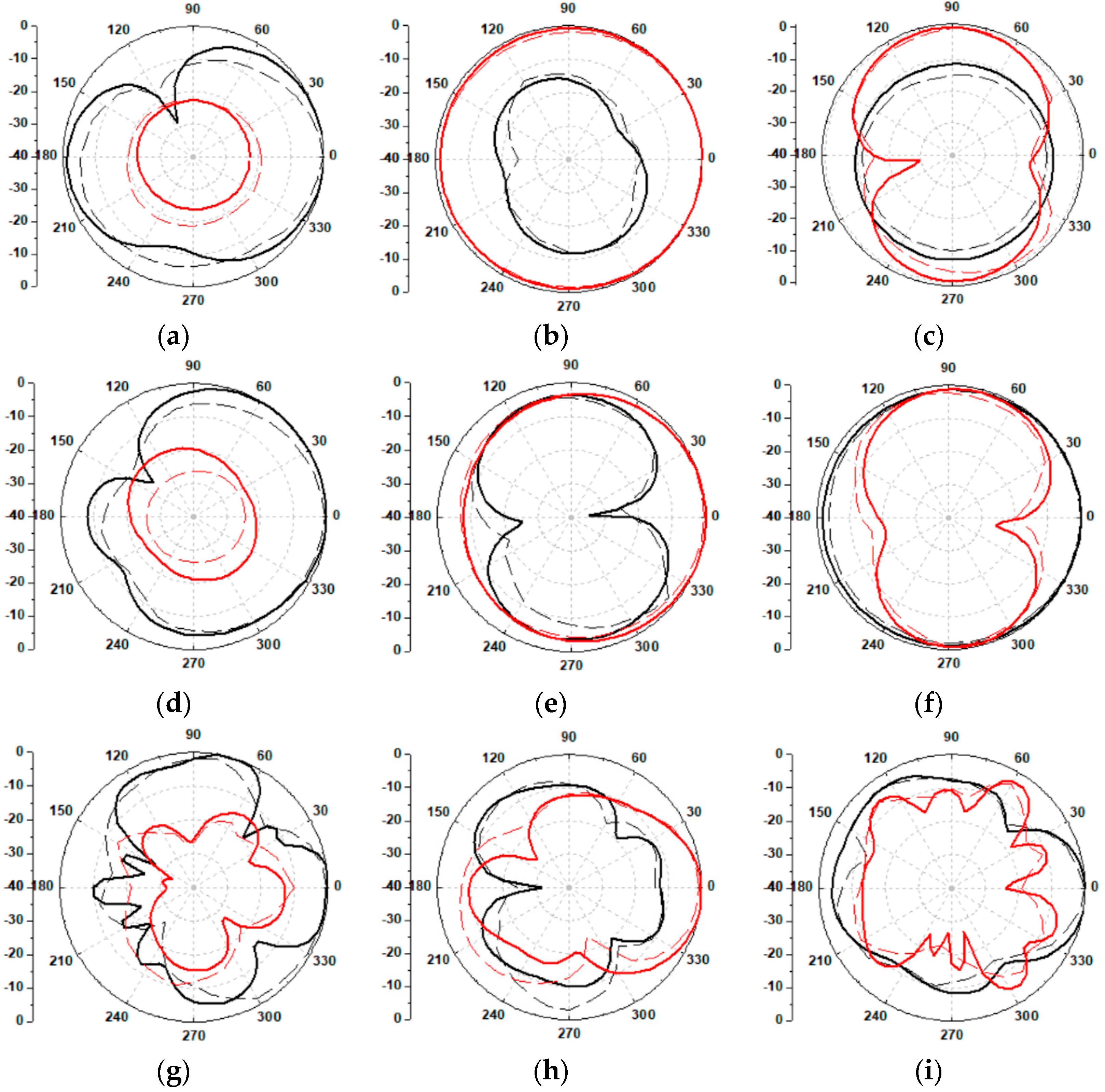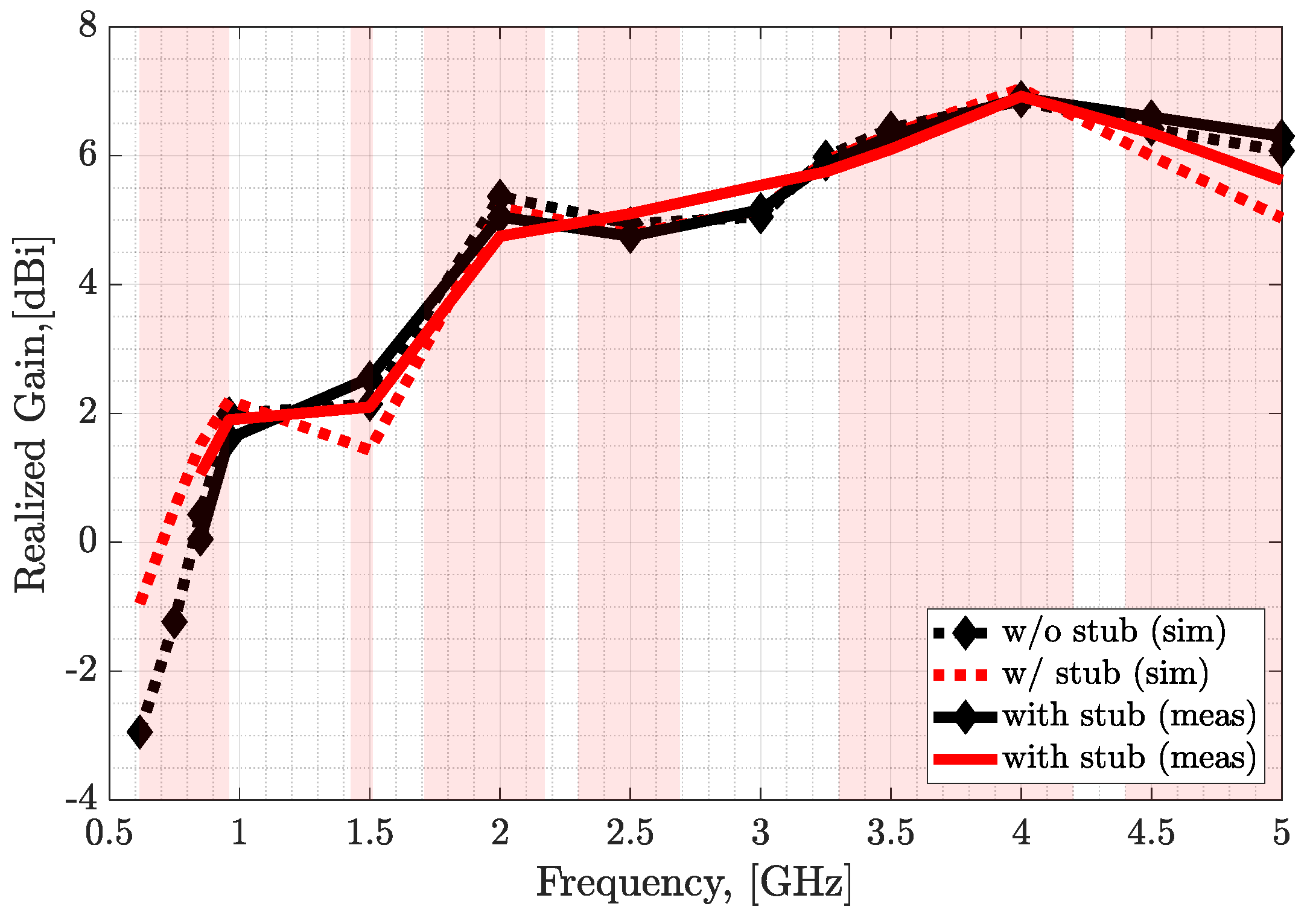A Compact and Wideband Dashboard Antenna for Vehicular LTE/5G Wireless Communications
Abstract
:1. Introduction
2. Antenna Layout
2.1. Design Steps of the Compact and Wideband Antenna Obtained from a Thin Metal Sheet
2.2. Simulated and Experimental Results
3. Conclusions
Author Contributions
Funding
Conflicts of Interest
References
- Zamberlan, D.; Pannozzo, M. Potential implications and road mapping of satellite bidirectional S-band antennas in the automotive market. IEEE Antennas Propag. Mag. 2014, 56, 240–250. [Google Scholar]
- Arumugam, S.; Manoharan, S.; Palaniswamy, S.K.; Kumar, S. Design and Performance Analysis of a Compact Quad-Element UWB MIMO Antenna for Automotive Communications. Electronics 2021, 10, 2184. [Google Scholar] [CrossRef]
- Rütschlin, M.; Tallini, D. Simulation for antenna design and placement in vehicles. In Proceedings of the Antennas, Propagation & RF Technology for Transport and Autonomous Platforms, Birmingham, UK, 2 February 2017; pp. 1–5. [Google Scholar]
- Gallo, M.; Bruni, S.; Zamberlan, D. Design and measurement of automotive antennas for C2C applications. In Proceedings of the 6th European Conference on Antennas and Propagation (EUCAP), Prague, Czech Republic, 1 June 2012; pp. 1799–1803. [Google Scholar]
- Navarro-Méndez, D.V.; Carrera-Suárez, L.F.; Antonino-Daviu, E.; Ferrando-Bataller, M.; Baquero-Escudero, M.; Gallo, M.; Zamberlan, D. Compact wideband Vivaldi monopole for LTE mobile communications. IEEE Antennas Wireless Propag. Lett. 2015, 14, 1068–1071. [Google Scholar] [CrossRef]
- Ghafari, E.; Fuchs, A.; Eblenkamp, D.; Aloi, D.N. A vehicular rooftop, shark-fin, multiband antenna for the GPS/LTE/cellular/DSRC systems. In Proceedings of the IEEE-APS Topical Conference on Antennas and Propagation in Wireless Communications (APWC), Palm Beach, Aruba, 3–9 August 2014; pp. 237–240. [Google Scholar]
- Michel, A.; Nepa, P.; Gallo, M.; Moro, I.; Filisan, A.P.; Zamberlan, D. Printed Wideband Antenna for LTE-Band Automotive Applications. IEEE Antennas Wirel. Propag. Lett. 2017, 16, 1245–1248. [Google Scholar] [CrossRef]
- Wong, K.; Huang, C. Triple-Wideband Open-Slot Antenna for the LTE Metal-Framed Tablet device. IEEE Trans. Antennas Propag. 2015, 63, 5966–5971. [Google Scholar] [CrossRef]
- Chung, M.-A.; Yang, C.-W. Miniaturized Broadband-Multiband Planar Monopole Antenna in Autonomous Vehicles Communication System Device. Electronics 2021, 10, 2715. [Google Scholar] [CrossRef]
- Guan, N.; Tayama, H.; Ueyama, M.; Yoshijima, Y.; Chiba, H. A roof automobile module for LTE-MIMO antennas. In Proceedings of the IEEE-APS Topical Conference on Antennas and Propagation in Wireless Communications (APWC), Turin, Italy, 7–11 September 2015; pp. 387–391. [Google Scholar]
- Leelaratne, R.; Langley, R. Multiband PIFA vehicle telematics antennas. IEEE Trans. Veh. Technol. 2005, 54, 477–485. [Google Scholar] [CrossRef]
- Cerretelli, M.; Tesi, V.; Gentili, G. Design of a shape-constrained dual-band polygonal monopole for car roof mounting. IEEE Trans. Veh. Technol. 2008, 57, 1398–1403. [Google Scholar] [CrossRef]
- Izquierdo, B.S.; Jun, S.; Heirons, J.; Acharya, N. Inkjet printed and folded LTE antenna for vehicular application. In Proceedings of the 46th European Microwave Conference (EuMC), London, UK, 4–6 October 2016; pp. 88–91. [Google Scholar]
- Friedrich, A.; Geck, B.; Klemp, O.; Kellermann, H. On the design of a 3D LTE antenna for automotive applications based on MID technology. In Proceedings of the 2013 European Microwave Conference, Nuremberg, Germany, 6–10 October 2013; pp. 640–643. [Google Scholar]
- Kaddour, A.S.; Bories, S.; Bellion, A.; Delaveaud, C. 3D printed compact dual-polarized wideband antenna. In Proceedings of the 11th European Conference on Antennas and Propagation (EUCAP), Paris, France, 19–24 March 2017; pp. 3441–3443. [Google Scholar]
- Trong, N.N.; Piotrowski, A.; Kaufmann, T.; Fumeaux, C. Low-Profile Wideband Monopolar UHF Antennas for Integration onto Vehicles and Helmets. IEEE Trans. Antennas Propag. 2016, 64, 2562–2568. [Google Scholar] [CrossRef]
- Goncharova, I.; Lindenmeier, S. A High Efficient 3D Nefer Antenna for LTE Communication on a Car. In Proceedings of the 8th European Conference on Antenna and Propagation (EuCAP), The Hague, The Netherlands, 6–11 April 2014; pp. 3273–3277. [Google Scholar]
- Franchina, V.; Michel, A.; Nepa, P.; Parolari, R.; Moro, I.; Filisan, A.P.; Zamberlan, D. A 3D LTE antenna for vehicular applications. In Proceedings of the IEEE International Symposium on Antennas and Propagation & USNC/URSI National Radio Science Meeting, San Diego, CA, USA, 9–14 July 2017; pp. 637–638. [Google Scholar]
- Li, M.; Behdad, N. A Compact, Capacitively Fed UWB Antenna with Monopole-Like Radiation Characteristics. IEEE Trans. Antennas Propag. 2017, 65, 1026–1037. [Google Scholar] [CrossRef]
- Wang, D.; Wen, G.; Rao, Q.; Pecen, M. A 3D compact pent- band antenna for wireless mobile communication. In Proceedings of the 2008 IEEE Antennas and Propagation Society International Symposium, San Diego, CA, USA, 5–11 July 2008; pp. 1–4. [Google Scholar]
- Kwon, O.Y.; Song, R.; Kim, B.S. A Fully Integrated Shark-Fin Antenna for MIMO-LTE, GPS, WLAN, and WAVE Applications. IEEE Antennas Wirel. Propag. Lett. 2018, 17, 600–603. [Google Scholar] [CrossRef]
- Goncharova, I.; Lindenmeier, S. A high efficient automotive roof antenna concept for LTE, DAB-L, GNSS and SDARS with low mutual coupling. In Proceedings of the 9th European Conference on Antennas and Propagation (EuCAP), Lisbon, Portugal, 13–17 April 2015; pp. 1–5. [Google Scholar]
- Kammerer, J.; Lindenmeier, S. A new compact antenna combination with high efficiency for reception of SDARS- and GPS signals. In Proceedings of the IEEE International Symposium on Antennas and Propagation, Chicago, IL, USA, 8–14 July 2012; pp. 1–2. [Google Scholar]
- Franchina, V.; Michel, A.; Nepa, P.; Gallo, M.; Parolari, R.; Filisan, A.P.; Zamberlan, D. A compact 3D antenna for automotive LTE MIMO applications. In Proceedings of the 2017 IEEE-APS Topical Conference on Antennas and Propagation in Wireless Communications (APWC), Verona, Italy, 11–15 September 2017; pp. 326–329. [Google Scholar]
- Melli, F.; Lenzini, S.; Cerretelli, M.; Coscelli, E.; Notari, A.; Selleri, S.; Vincetti, L. Low Profile Wideband 3D Antenna for Roof-Top LTE Vehicular Applications. In Proceedings of the 2019 IEEE-APS Topical Conference on Antennas and Propagation in Wireless Communications (APWC), Granada, Spain, 9–13 September 2019; pp. 157–159. [Google Scholar]
- Hastürkoğlu, S.; Almarashli, M.; Lindenmeier, S. A Compact Wideband Terrestial MIMO-Antenna Set for 4G, 5G, WLAN and V2X and Evaluation of its LTE-Performance in an Urban Region. In Proceedings of the 13th European Conference on Antennas and Propagation (EuCAP), Krakow, Poland, 31 March–5 April 2019; pp. 1–5. [Google Scholar]
- Khalifa, M.O.; Yacoub, A.M.; Aloi, D.N. A Multiwideband Compact Antenna Design for Vehicular Sub-6 GHz 5G Wireless Systems. IEEE Trans. Antennas Propag. 2021, 69, 8136–8142. [Google Scholar] [CrossRef]
- Nasr, A.; Sarabandi, K.; Takla, M. Multi-beam Dual-Polarized Windshield Antenna with Wide Elevation Coverage for 5G V2X Applications. In Proceedings of the IEEE International Symposium on Antennas and Propagation and North American Radio Science Meeting, Montreal, QC, Canada, 5–10 July 2020; pp. 1333–1334. [Google Scholar]
- Artner, G.; Langwieser, R.; Mecklenbräuker, C.F. Concealed CFRP Vehicle Chassis Antenna Cavity. IEEE Antennas Wirel. Propag. Lett. 2017, 16, 1415–1418. [Google Scholar] [CrossRef]
- Artner, G.; Kotterman, W.; Galdo, G.D.; Hein, M.A. Conformal Automotive Roof-Top Antenna Cavity with Increased Coverage to Vulnerable Road Users. IEEE Antennas Wirel. Propag. Lett. 2018, 17, 2399–2403. [Google Scholar] [CrossRef]
- CST Studio Suite. Available online: https://www.3ds.com/products-services/simulia/products/cst-studio-suite/ (accessed on 20 June 2022).











| Parameter | Value (mm) | Parameter | Value (mm) |
|---|---|---|---|
| H | 45 | LG | 143.5 |
| L1 | 34.6 | W | 40 |
| L2 | 35.3 | WG | 47 |
| L3 | 28.1 |
| Parameter | Value (mm) | Parameter | Value (mm) |
|---|---|---|---|
| H | 35 | L5 | 12 |
| L | 40 | L6 | 12.5 |
| L1 | 35.8 | L7 | 30 |
| L2 | 29.1 | t | 5 |
| L3 | 35 | W | 40 |
| L4 | 27 |
| Operating Frequency Bands (MHz) | Total Efficiency | Peak Gain in Operating Bands (dBi) | Total Size (mm3) | Technique Used | Antenna Type | |
|---|---|---|---|---|---|---|
| [6] | 698–960, 1700–2700, 5100–6000 | >10% (698–960 MHz), >80% (1700–2700 MHz), >70% (5100–6000 MHz) | Not given | 37.6 × 40 × 0.8 | Shorted monopole | Printed |
| [9] | 2000–2740, 4062–8000 | >85% (2000–2740 MHz), >80% (4062–8000 MHz) | >2.7 (2000–2740 MHz) >2.6 * (4062–8000 MHz) | 50 × 10 × 0.8 | Monopole | Printed |
| [19] | 576–2985 | >85% | >2.0 | Diameter is 62.6 mm and height is 39 mm | Monopole | 3D |
| [21] | 850, 1575, 2400, 5900 | >30.7% | Not given | 59.5 × 44.3 × 21 | Planar inverted-F | 3D |
| [22] | 698–960, 1427–2700 | 68% | 2.8 (900 MHz), 4.8 (1700 MHz) | 55 × 33 × 10 | Monopole | 3D |
| [25] | 700–960, 1700–2700 | Not given | −4.5 * (850 MHz), −0.3 * (1700 MHz) | Not given | Monopole | 3D |
| [26] | 700–6000 | >−1.5 dB | Not given | 70 × 70 × 29 | Wideband Nefer monopole | 3D |
| [27] | 617–5000 | >62% | Linear Average Gain > 0 dB | 15 × 39.8 × 60 | Monopole | 3D |
| This work (second configuration) | 617–5000 | >62% (670–960 MHz), >75% (1410–1550 MHz) >82% (1710–5000 MHz) | >−0.5 (670–960 MHz), >1.4 (1410–1550 MHz), >3.2 (1710–5000 MHz), | 40 × 40 × 35 | Monopole with shunt stub | 3D |
Publisher’s Note: MDPI stays neutral with regard to jurisdictional claims in published maps and institutional affiliations. |
© 2022 by the authors. Licensee MDPI, Basel, Switzerland. This article is an open access article distributed under the terms and conditions of the Creative Commons Attribution (CC BY) license (https://creativecommons.org/licenses/by/4.0/).
Share and Cite
Michel, A.; Singh, R.K.; Nepa, P. A Compact and Wideband Dashboard Antenna for Vehicular LTE/5G Wireless Communications. Electronics 2022, 11, 1923. https://doi.org/10.3390/electronics11131923
Michel A, Singh RK, Nepa P. A Compact and Wideband Dashboard Antenna for Vehicular LTE/5G Wireless Communications. Electronics. 2022; 11(13):1923. https://doi.org/10.3390/electronics11131923
Chicago/Turabian StyleMichel, Andrea, Rajesh Kumar Singh, and Paolo Nepa. 2022. "A Compact and Wideband Dashboard Antenna for Vehicular LTE/5G Wireless Communications" Electronics 11, no. 13: 1923. https://doi.org/10.3390/electronics11131923








